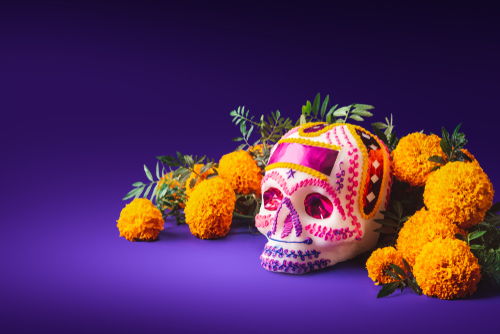On the 1st and 2nd of November, Mexican families gather to celebrate Día de los Muertos, or the Day of the Dead. If you grew up with this tradition, you’ll know it’s not just about colourful altars or sugar skulls, but about remembering and feeling close to the people you love, even after they’ve gone.
At Remitly, we understand what it’s like to be far from home and still want to hold onto the traditions that shaped you. For immigrants and expats in the UK, celebrating Day of the Dead isn’t just about looking back; it’s a way to stay connected to family, keep heritage alive, and share something deeply meaningful with your new community.
What is Day of the Dead?
To understand how special Día de los Muertos really is, we need to dig into the history and cultural heritage behind it. The holiday goes back thousands of years, finding its roots in Aztec rituals that honoured the cycle of life and death.
When Spanish colonisers arrived, these traditions blended with Catholic holidays like All Saints’ Day and All Souls’ Day. The result is the Day of the Dead as we know it today: a unique mix of Indigenous and Christian customs that celebrate memory, family, and the beauty of life itself.
The modern evolution of Día de los Muertos is celebrated across two days. On the 1st of November (Día de los Inocentes or Día de los Angelitos), families remember children who have passed away, while the 2nd of November is dedicated to honouring adults. Specific traditions can vary from region to region.
Meaning and significance
These days are far from sombre. Instead, they’re filled with food, laughter, and stories as families welcome loved ones back for a joyful reunion.
At its core, Day of the Dead is a celebration of love that doesn’t fade with time. Families believe that through light, flowers, and offerings, the spirits of those they’ve lost can return to visit. It’s a holiday that transforms grief into connection and memory into celebration.
Day of the Dead vs Halloween in the UK
Since the Day of the Dead happens just after Halloween, the two often get mixed up. But once you know the difference, you’ll see that they couldn’t be more distinct.
Halloween is all about costumes, scary films, and trick-or-treating. Day of the Dead, on the other hand, is about remembering and celebrating loved ones. Instead of pumpkins and jump scares, you’ll find altars filled with flowers, food, and photos—symbols of welcome and love.
The mix-up usually comes from the shared symbols of skulls and skeletons. In the UK, sugar skulls might look like quirky Halloween decorations, but in Mexico, they’re powerful symbols of the cycle of life and death.
Key Day of the Dead traditions and symbols
One reason Día de los Muertos captures so many hearts is its touching traditions and bright imagery. Each symbol has a story, and together they create a celebration that feels both joyful and deeply moving.
Altars (ofrendas)
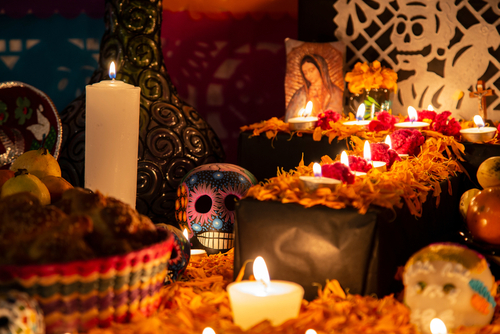
The centrepiece of the holiday is the ofrenda, or altar. Families set them up at home and decorate them with photos, candles, flowers, and favourite foods of loved ones.
Many altars are built with three levels, symbolising earth, purgatory, and heaven. More than mere decorations, these altars are a heartfelt invitation for spirits to return and join the celebration.
Marigold flowers (cempasúchil)
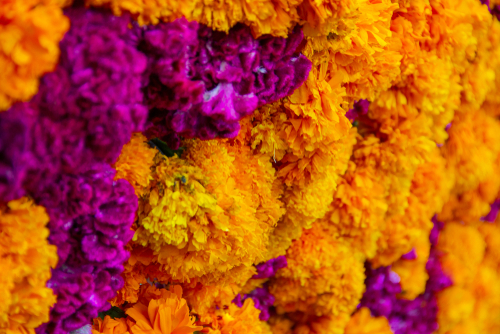
If there’s one flower that defines Día de los Muertos, it’s the cempasúchil, or marigold. Their bright orange petals and strong scent are believed to guide spirits home. In Mexico, families often create trails of marigold petals leading from cemeteries to their homes.
Sugar skulls and pan de muerto
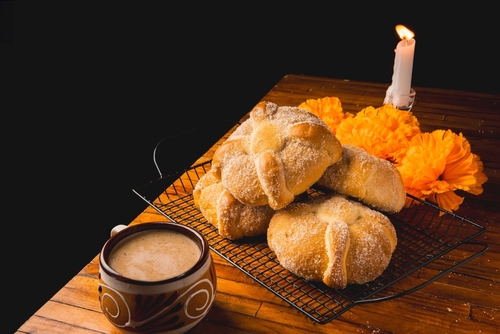
Sugar skulls are a cornerstone of the celebration. Brightly decorated with icing and sometimes even inscribed with names, they’re playful, colourful reminders of life and death. Families also share pan de muerto, a soft, sweet bread often topped with bone-shaped designs.
Why Day of the Dead resonates with immigrants
For many people living abroad, Día de los Muertos takes on even greater meaning. Beyond celebrating a tradition, the event can help create a sense of connection when you’re far from home.
Honouring loved ones
When visiting graves isn’t possible, a home altar or community event can be a comforting way to feel close to loved ones. For many immigrants, creating this space becomes a bridge across distance and time.
Building a sense of community abroad
Day of the Dead is also about coming together. In the UK, Mexican cultural groups often welcome anyone who wants to take part, creating opportunities to meet new people, share stories, and celebrate as a community.
The beauty of Día de los Muertos is that its message reaches beyond Mexico. It’s about love, memory, and family—values that resonate with people everywhere. Whether you’re Mexican or not, the holiday offers a way to remember and celebrate those you’ve lost.
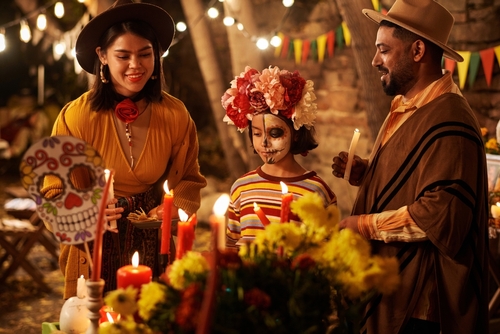
Day of the Dead in popular culture
In recent years, popular culture has played a big role in introducing this holiday to new audiences around the world.
Films and media that shaped awareness
Disney Pixar’s Coco is perhaps the best-known example. The film’s stunning visuals and heartfelt story about family, memory, and music introduced the tradition to millions of viewers worldwide.
Before that, the James Bond film Spectre opened with a dazzling Day of the Dead parade in Mexico City, sparking international fascination and even inspiring real-life parades in Mexico.
More recently, TV shows like Maya and the Three on Netflix and even references in The Book of Life have helped weave the imagery of marigolds, candles, and colourful calaveras into mainstream culture.
Impact on celebrations abroad
These cultural touchpoints have done more than entertain: they’ve inspired museums, schools, and community groups in places like the UK to host their own Day of the Dead events.
You might see pop-up exhibitions, film screenings, or even craft workshops making papel picado (a brightly coloured paper decoration similar to bunting) or decorating sugar skulls. While popular culture offers an inviting introduction, it’s the deeper understanding of the holiday’s history and meaning that makes taking part truly special.
How to celebrate Day of the Dead in the UK
Living in the UK doesn’t mean you have to miss out on Día de los Muertos. Whether at home or in your community, there are plenty of ways to make the holiday your own:
- Create your own ofrenda at home: A simple way to celebrate is by building your own ofrenda. Pick a shelf or small table, add photos of loved ones, light a few candles, and place flowers or mementoes that remind you of them. If marigolds aren’t available, orange chrysanthemums or dahlias are perfect substitutes. Add in their favourite food or drink, and your altar becomes a warm space filled with memory and love.
- Attend community events: If you’d rather celebrate with others, many UK cities now host events. London, Manchester, and Edinburgh often feature parades, exhibitions, and concerts inspired by the holiday. Museums like the British Museum and the Horniman Museum in London also organise themed activities, offering both education and celebration.
- Get children involved: This is also a family holiday, and children can play a big role. Crafts like papel picado or decorating sugar skulls are fun and meaningful. Storytelling is another wonderful way to involve kids; sharing memories of grandparents or relatives helps them feel connected to family history.
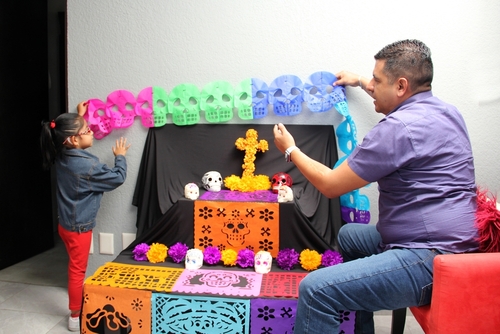
Where to find supplies in the UK
As Day of the Dead becomes more widely celebrated, it’s easier than ever to find supplies, even outside of Mexico.
Websites like Etsy and Amazon UK sell papel picado, sugar skulls, and altar decorations. Around late October, you might also spot themed items in cultural shops or craft stores. Garden centres and supermarkets stock colourful seasonal flowers that can easily stand in for marigolds.
If you live in a city, look out for Mexican grocery shops, or tiendas. Many sell pan de muerto, Mexican hot chocolate, and other festive items in the lead-up to November. They’re also a wonderful way to connect with the local Mexican community.
DIY alternatives
If you can’t find what you need, making your own is part of the fun. Papel picado is easy to craft from coloured tissue paper, and baking pan de muerto at home can be a memorable way to celebrate with family or friends. Even if you use chrysanthemums instead of marigolds, the spirit of remembrance is what matters most.
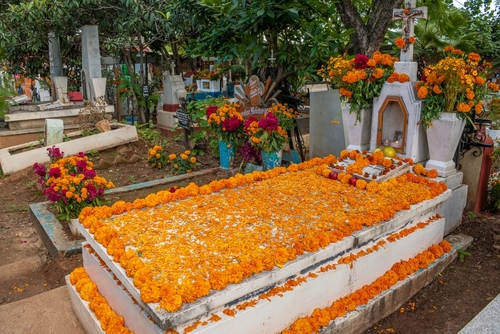
Joining in on Day of the Dead celebrations
With more people in the UK discovering Día de los Muertos each year, it’s worth noting the importance of celebrating this tradition respectfully. Unlike Halloween, this holiday isn’t about fancy dress and sweets. Skulls and flowers are powerful symbols, but they should be worn with understanding, not as accessories.
Do’s
- Learn about the history of the holiday and why it’s important in Mexican culture.
- Support local Mexican-owned businesses or cultural groups by joining events, buying decorations, or enjoying traditional foods.
- Focus on the heart of the holiday: celebrating the memory of those who have passed.
Don’ts
- Don’t confuse Day of the Dead with Halloween or use it as an excuse for costumes.
- Don’t rely on stereotypes or reduce the holiday to just colourful décor.
- Resist commercialising the celebration; approach it with openness, respect, and intention.
Whether you light a candle for a loved one, bake pan de muerto with friends, or attend a local community event, Día de los Muertos is a reminder that love never really leaves us. Celebrating it respectfully honours Mexican culture and brings a timeless message of family and remembrance into our lives.
FAQs
When is Day of the Dead celebrated?
Day of the Dead takes place on the 1st and 2nd of November every year. The first day is dedicated to children, while the second honours adults.
Is Day of the Dead the same as Halloween?
No. Halloween focuses on costumes and scares, while Día de los Muertos is about celebrating the memory of loved ones with joy.
Can I celebrate Day of the Dead if I’m not Mexican?
Yes. Anyone can take part, as long as they approach the holiday with respect and understanding.
Where can I find Day of the Dead events in the UK?
Events are most common in cities like London, Manchester, and Edinburgh, often organised by museums or cultural centres. Checking event listings online is the best way to find them.
